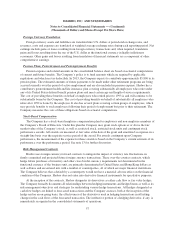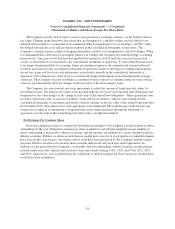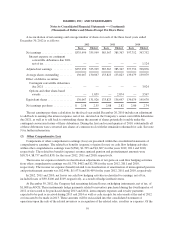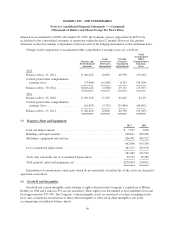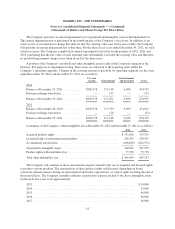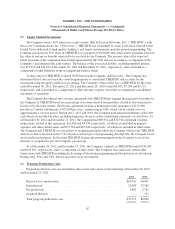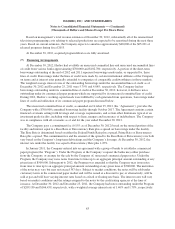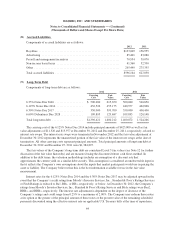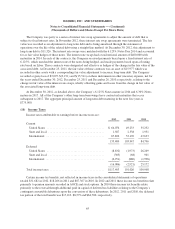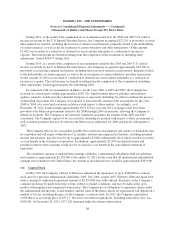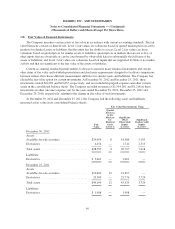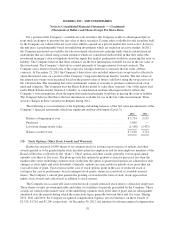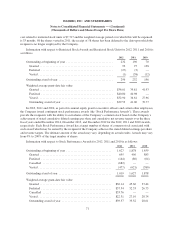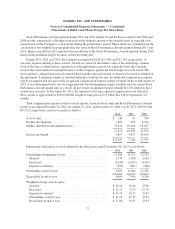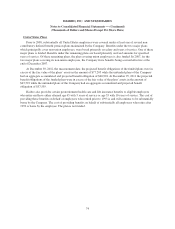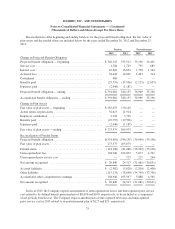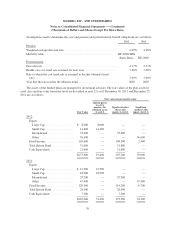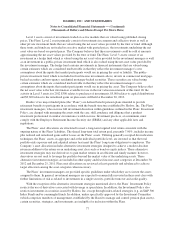Hasbro 2012 Annual Report Download - page 77
Download and view the complete annual report
Please find page 77 of the 2012 Hasbro annual report below. You can navigate through the pages in the report by either clicking on the pages listed below, or by using the keyword search tool below to find specific information within the annual report.
HASBRO, INC. AND SUBSIDIARIES
Notes to Consolidated Financial Statements — (Continued)
(Thousands of Dollars and Shares Except Per Share Data)
Hasbro has a valuation allowance for certain deferred tax assets at December 30, 2012 of $17,145, which is a
decrease of $1,000 from $18,145 at December 25, 2011. The valuation allowance pertains to certain U.S. State and
International loss carryforwards, some of which have no expiration and others that would expire beginning in 2015.
Based on Hasbro’s history of taxable income and the anticipation of sufficient taxable income in years when
the temporary differences are expected to become tax deductions, the Company believes that it will realize the
benefit of the deferred tax assets, net of the existing valuation allowance.
At December 30, 2012 and December 25, 2011, the Company’s net deferred income taxes are recorded in
the consolidated balance sheets as follows:
2012 2011
Prepaid expenses and other current assets ............................. $ 85,429 68,774
Other assets .................................................... 79,746 62,574
Accrued liabilities ............................................... (641) (731)
Other liabilities .................................................. (1,057) (1,197)
Net deferred income taxes ......................................... $163,477 129,420
A reconciliation of unrecognized tax benefits, excluding potential interest and penalties, for the fiscal years
ended December 30, 2012, December 25, 2011, and December 26, 2010 is as follows:
2012 2011 2010
Balance at beginning of year ............................... $ 83,814 91,109 97,857
Gross increases in prior period tax positions ................. 3,089 811 706
Gross decreases in prior period tax positions ................ (10,856) (33,501) (36,010)
Gross increases in current period tax positions ............... 30,008 27,910 34,598
Decreases related to settlements with tax authorities .......... — (792) (5,550)
Decreases from the expiration of statute of limitations ......... (2,988) (1,723) (492)
Balance at end of year .................................... $103,067 83,814 91,109
If the $103,067 balance as of December 30, 2012 is recognized, approximately $90,000 would decrease the
effective tax rate in the period in which each of the benefits is recognized. The remaining amount would be offset
by the reversal of related deferred tax assets.
During 2012, 2011, and 2010 the Company recognized $3,110, $3,100 and $3,171, respectively, of potential
interest and penalties, which are included as a component of income taxes in the accompanying consolidated
statements of operations. At December 30, 2012, December 25, 2011 and December 26, 2010, the Company had
accrued potential interest and penalties of $20,377, $13,847 and $14,466, respectively.
The Company and its subsidiaries file income tax returns in the United States and various state and
international jurisdictions. In the normal course of business, the Company is regularly audited by U.S. federal,
state and local and international tax authorities in various tax jurisdictions. The Company is no longer subject to
U.S. federal income tax examinations for years before 2008. With few exceptions, the Company is no longer
subject to U.S. state or local and non-U.S. income tax examinations by tax authorities in its major jurisdictions
for years before 2006.
The U.S. Internal Revenue Service is conducting an examination related to the Company’s 2008 and 2009
U.S. federal income tax returns. The Company is also under income tax examination in several U.S. state and
local and non-U.S. jurisdictions.
67


